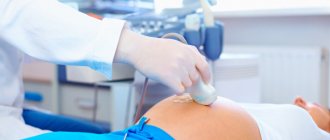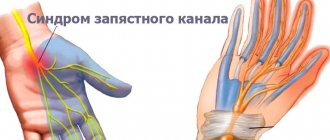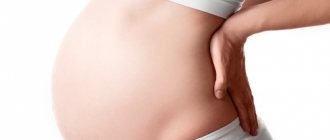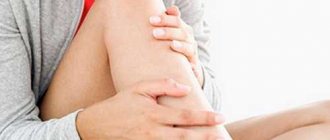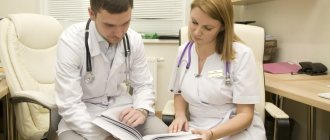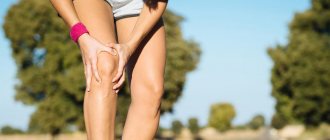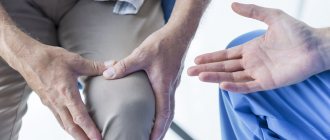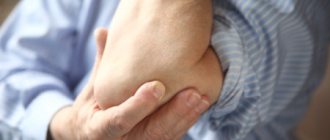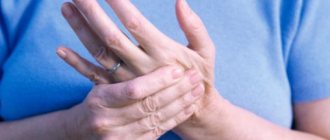Carrying a child is a long process during which the body of the expectant mother undergoes significant changes. Changes are happening both internally and externally. A woman’s abdomen and mammary glands increase in size, sensitivity increases, and hormonal balance changes. The main load falls on the internal organs and skeleton, especially the legs. If your hip hurts and pulls during pregnancy, this can be either normal or pathological. To draw the correct conclusion, it is necessary to understand the nature of the sensations, the place of their occurrence and the reasons.
Types of pain in the hips
During pregnancy, the spine and joints experience increased stress.
Classification of hip pain during pregnancy takes into account their cause, duration, time of onset and location. Main types:
- Mechanical. Discomfort in the hip joint appears as a result of prolonged physical activity. After a good rest it goes away.
- Starters. Appear with the beginning of any physical action. For example, when a woman gets up from a chair, quickens her pace, or lies down on the bed. They pass quickly.
- Nighttime. The problem is caused by incorrect posture and pinching of the sciatic nerve.
- Reflected. Referring pain in the hip area from the back or abdomen. A sign of pathologies of internal organs.
The last type of pain is the most dangerous. In this case, eliminating the symptom does not solve the problem, but only aggravates it by delaying treatment. A pregnant woman must consult a doctor and undergo a full examination.
Why do hip joints hurt during late pregnancy and what to do?
The first thing to do if your joints hurt during pregnancy is to look for an experienced manual therapy specialist. The doctor must have a specialization in orthopedics. He will be able to give a set of individual recommendations, subject to which the patient will be able to eliminate the risk of destruction of the hip joints and will be able to effectively prepare for future labor.
Above, we have already indicated why the hip joint hurts during pregnancy, what potential causes can provoke the appearance of this symptom. In fact, this condition is pathological and can be attributed to the first stage of the development of osteoarthritis. This pathology is often associated with incorrect position of the femoral head in the cavity of the acetabulum, large body weight and lack of regular physical activity on the femoral and gluteal muscle groups. All these negative influences exist during pregnancy.
You can eliminate them using simple preventive measures:
- you need to stop wearing shoes that bend the foot (high heels, tight lasts, narrow insteps, etc.);
- be sure to use a prenatal bandage even with a small abdominal volume;
- monitor a sufficient amount of food rich in calcium and vitamin D in your diet; if necessary, you need to make a correction using selected vitamin and mineral complexes;
- perform special gymnastic exercises that are developed by an orthopedist individually for each pregnant woman to strengthen the muscles of the thigh and gluteal region;
- attend massage sessions that improve blood circulation in the pelvic cavity, in the hip joints and lumbosacral spine.
Very often, joints hurt during late pregnancy, when it is already possible to use all types of manual therapy techniques. Therefore, we recommend that you categorically refuse to use non-steroidal anti-inflammatory drugs for pain relief, even in the form of an ointment for external use. in case of hormonal imbalance, their use can lead not only to the development of severe bleeding, but also to the appearance of pronounced cosmetic skin defects (pigmentation, bumpiness, inflammation, etc.).
If you are experiencing hip pain during pregnancy and are unsure what to do, we encourage you to schedule a free initial consultation with our manual therapy clinic. During the appointment, the doctor will conduct an examination and diagnosis. After diagnosis, an individual course of therapy will be developed taking into account the condition of the pregnant woman.
During a free consultation, you will not only learn about why joints hurt during pregnancy, but also receive comprehensive recommendations on how to prevent the process of destruction of cartilage and bone tissue. These tips and therapy techniques will help you prepare your musculoskeletal system for future birth and subsequent recovery.
Pain point location
The location of pain plays an important role in making the correct diagnosis. When sensations radiate to the lower back, abdomen, knees or internal organs, it is more difficult to diagnose the pathology. In addition to the traditional examination by a doctor, you will need to undergo a number of examinations and pass basic tests.
The most common places of pain points:
- If the inner thigh hurts during pregnancy, it means natural preparation for childbirth has begun. There is a stretching of muscles and ligaments, divergence of the pelvic bones.
- If the hip hurts from the pelvis, near the gluteal muscles, the cause is most likely inflammation of the sciatic nerve. In medicine, the disease is characterized as lumbosacral radiculitis.
- The occurrence of pain in the pubic area is a sign of symphysitis (divergence of the womb). The problem is typical for late periods.
Also, in order to identify the cause of the problem, it is recommended to pay attention to the frequency of pain, its duration and nature.
Causes of pain
The physical health of the mother, hormonal characteristics, fetal size, deficiency of vitamins and minerals are only a small part of what can cause pain in the hips on the sides during pregnancy. More details about each of them:
- Sedentary lifestyle. Lack of physical activity before pregnancy significantly complicates its course. The back muscles, spine and joints are unprepared for the load.
- Diseases of the musculoskeletal system. These include osteochondrosis, arthrosis of the hip joint, bone injuries and vertebral displacement, and intervertebral hernia.
- Vitamin deficiency, deficiency of minerals and other nutrients. For the full development of the fetus, the daily norm of all microelements must be increased several times. Only calcium and phosphorus require 1.5 grams each. Their deficiency is dangerous due to the development of symphysitis, osteoporosis, osteomalacia and impaired phosphorus-calcium metabolism in the mother.
- Physiological changes. Pressure on the pelvic bones increases as a result of an enlarged uterus. This is where lumbosacral radiculitis and pinching of the sciatic nerve develop.
- Overwork. Excessive walking, heavy physical activity, and heavy lifting cause hip pain during pregnancy. In the 3rd trimester the problem becomes more pronounced.
- Preparing for childbirth. Discomfort in the hip area is associated with softening of the interosseous joints, relaxation of muscles and ligaments, and separation of the pelvic bones. All this is necessary for the birth of a baby naturally.
Along with pain in the thigh, a burning and tingling sensation may occur, radiating to the limb. When changing position or walking, you may hear a crunching sound, click, or feel the joint shift.
Useful tips
To reduce the severity of pain in the hip joints that occurs for natural and pathological reasons, cold compresses are used. Gynecologists do not recommend using an ice pack for procedures. A woman's immunity during pregnancy is not very strong, so exposure to low temperatures should be avoided. For compresses, a thick cloth or towel soaked in cool water is suitable. It is applied to the area of pain for 20-30 minutes.
If exercise therapy and changing your diet helped improve your well-being, then you need to continue to adhere to this lifestyle. To ensure that joint pain no longer mars the wonderful time of waiting for the baby, preventive measures should be taken. Gynecologists advise adhering to the following rules:
- wear comfortable shoes with low heels, purchase special orthopedic inserts. During walking, such devices distribute the load on the heel, toes, and lateral surfaces of the foot, and prevent the formation of edema;
- Use a maternity brace while walking or doing housework. Wearing an orthopedic product helps relieve stress from the back, prevents varicose veins, and prevents early descent of the fetus;
- sleep only on your side. Sleeping on your back increases the likelihood of compression of the vena cava, which carries a large volume of blood. Its narrowing will cause circulatory problems in the lower extremities and serve as a prerequisite for the development of varicose veins or chronic venous insufficiency, the leading symptom of which is pain in the lower extremities.
To increase muscle tone, doctors advise massaging the thighs: stroking, patting, rubbing. To increase the effectiveness of procedures, you can use cosmetic oils of almond, grape seed, apricot, and wheat germ.
If chronic pathologies of the musculoskeletal system worsen during pregnancy, they are treated with drugs in reduced dosages. And with the development of inflammatory or degenerative diseases of the joints, it is necessary to diagnose them as quickly as possible and begin treatment. This will avoid the progression of arthritis, osteoarthritis, and lumbosacral osteochondrosis.
Ways to eliminate or relieve hip pain
Comprehensive therapy based on exercise and painkillers will help get rid of unpleasant symptoms and prevent the development of the disease.
To prescribe appropriate medications and draw up a treatment regimen, you should consult a doctor. Self-administration of painkillers is dangerous due to miscarriage and fetal pathologies.
The first medical office you should visit is the gynecological office. From here, the specialist can refer the patient to a neurologist or surgeon. 1-2 weeks before birth, pain in the pelvic area is considered normal and does not require intervention. If your hips hurt during early pregnancy, follow the general recommendations:
- Balance your daily diet. Introduce fermented milk products, nuts, legumes, fish and lean meat into the menu. Compensate for the lack of phosphorus and calcium with multivitamin complexes.
- Use a bandage to relieve back tension.
- Sleep on an orthopedic mattress to avoid pinching the sciatic nerve and other problems with the spine and neck.
- Visit a massage room regularly or learn basic relaxation techniques on your own.
- Limit physical activity.
- Wear shoes with orthopedic soles and heels no higher than 3 cm.
- Take a warm bath 1-2 times a week.
The unshakable rules for all pregnant women remain walking in the fresh air, receiving positive emotions and healthy, sound sleep. If the pain is severe and intense, use special relaxing poses and exercises. The most effective of them:
- "Cat's back." Get on your knees and focus on your hands. Relax your back muscles, keeping your neck, head and spine in line. Then arch your back up, lower your head, and tighten your hips and stomach. Repeat 2-3 times.
- "Half-bridge." Lie on your back and bend your knees. Lift your lower back and pelvis up, focusing on your feet. Hold the position for 5 seconds. Perform 2 sets of 10 times.
- "Camelback". Get on all fours and raise your head up. Bend your back down and hold in this position for 5 seconds. Repeat 10 times.
- "Frog". Lie on your back, bend your knees and bring your feet toward your buttocks. Slowly spread your knees out to the sides without lifting your feet off the floor. Repeat 5-6 times.
Be sure to stretch before and after exercise. This will enhance the effect and keep your muscles toned.
In addition to the main therapy, during sleep and rest, use a special back cushion or pillow for pregnant women. The products help you adopt the correct posture and relieve discomfort.
How to get rid of uncomfortable feelings
To eliminate any pain before conception, it was enough to simply take an analgesic tablet. During pregnancy, you will have to forget about pharmacological drugs. A doctor may prescribe a drug with an analgesic effect, but only for acute pain and in reduced doses. To improve well-being, a woman needs to make adjustments to her usual lifestyle. Taking preventive measures will also help get rid of pain.
Diet
The expectant mother always tries to eat right. She excludes smoked foods, fatty and fried foods, and foods high in spices and salt from the daily menu. This helps avoid the formation of swelling in the legs, which often causes pain when walking. Counting calories allows you to avoid gaining extra pounds, which leads to excess stress on the hip joints.
But it is also very important to eat foods containing a lot of calcium, phosphorus, magnesium, copper, potassium, and selenium. It is useless to rely on fresh vegetables and fruits during the cold season. They contain enough coarse fiber and complex carbohydrates, but few vitamins and microelements. Therefore, gynecologists managing pregnancy prescribe special balanced complexes of biologically active substances to expectant mothers - Elevit Pronatal, Alphabet and Complivit for pregnant women, Centrum, Vitrum, Multitabs, Selmevit.
Physiotherapy
The most effective way to quickly get rid of hip pain during pregnancy is daily physical therapy exercises. A set of exercises is compiled individually for a woman by a physical therapy doctor. The first training sessions take place under his leadership. Regular exercise helps improve blood circulation in the lower extremities, strengthens the muscle corset, and prepares the body for the upcoming birth. During training, you should avoid movements that cause discomfort. The goal of the exercises is to improve well-being, not to increase muscle volume. What exercises are most effective:
- lie on your back, raise your legs bent at the knees 30-40 cm from the floor. Try to hold them in this position for 15 seconds and then slowly lower them. Exercise helps get rid of swelling of the ankles;
- sit on a chair, or better yet, a low stool, raise your leg and do 10 rotations, first in one direction, then in the other direction. Repeat the exercise using the other leg. If you can’t completely perform a set of movements right away, you can do it in 2-3 approaches;
- lie on your side, smoothly raise and lower your straightened leg 20-30 times. Roll over to the other side and repeat the exercise. In the later stages of pregnancy, such movements are difficult, so you should raise and lower your legs to a small height and fewer times;
- lying on your back, raise your legs, smoothly spread them apart, and then bring them together 20-30 times. If your stomach is already large enough, then you can perform the exercise with your knees bent.
In case of severe swelling, you need to lie down and place your legs on a thick cushion or pillow and simply rotate your feet from side to side. One of the basic rules of training while carrying a child is that when performing exercises, the load should be evenly distributed on the muscles of the legs, and not the abdomen.
Gymnastics for the pelvic area:
How to prevent pain and heaviness in your hips
The most reliable and easiest way to prevent pain and heaviness in the hips when carrying a child is planning your pregnancy and carefully preparing for it. You can learn more about this at the antenatal clinic, where they will offer to take tests and undergo the necessary examination. Afterwards, it is recommended to start leading a healthy lifestyle and get rid of bad habits forever.
If this stage is missed, at the first symptoms you should consult a doctor and adhere to the above recommendations. Other ways to prevent hip pain:
- Courses for pregnant women. During the classes they teach useful breathing techniques, physical exercises and provide valuable recommendations for improving the quality of life in the “position”.
- Sports activities. During pregnancy, you can master various types of physical activity - yoga, dancing, gymnastics, swimming, stretching, aerobics, etc. In the process, blood circulation and the functioning of the musculoskeletal system as a whole are improved, stress levels are reduced and hormonal levels are normalized.
After childbirth, there is a possibility of worsening hip pain. For prevention, it is recommended to continue exercising and taking prescribed vitamins. To control the situation and not allow the problem to worsen, regularly visit a rheumatologist and massage therapist.
Safe treatment of joints during pregnancy
In order to safely treat joints during pregnancy, it is necessary to completely abandon any pharmacological drugs. Most of them have a negative effect not only on the mother’s body, but also can create prerequisites for intrauterine malformations of the fetus.
Our manual therapy clinic employs experienced specialists. They use specially developed techniques in their work:
- massage allows you to prepare muscle tissue for increasing loads and subsequent labor;
- osteopathy launches the processes of natural tissue regeneration by using the body’s hidden reserves;
- reflexology improves the general condition of the body and increases its vitality;
- kinesitherapy and therapeutic exercises improve the condition of the ligamentous, muscular, and bone apparatus.
Treatment begins with an accurate diagnosis. Pain in the hip joint cannot occur on its own. It can only be a symptom of some disease. And the final result depends on the accuracy of the diagnosis and the correctness of the prescribed treatment. Therefore, it is very important not to engage in independent treatment, but to seek help from an experienced orthopedic doctor.
